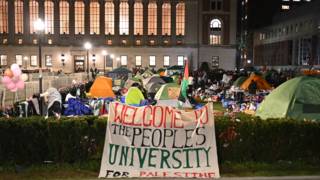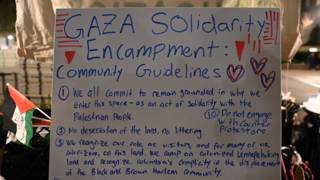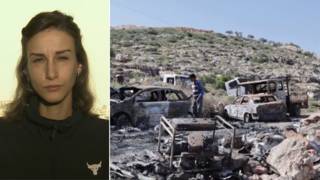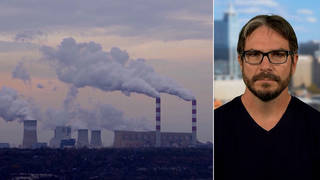
Related
Topics
Guests
- Eriel Tchekwie Derangerfounder and executive director of the group Indigenous Climate Action and a member of the Athabasca Chipewyan First Nation.
- Peter Millerdirector of the western region Climate & Clean Energy Program for the Natural Resources Defense Council.
Protesters disrupted the Global Climate Action Summit Thursday, criticizing California Governor Jerry Brown in part for his support for cap and trade. Cap and trade is a market-driven strategy in which governments cap emission levels, then allow companies to buy and sell permits to pollute. California has the most far-reaching cap-and-trade program in the United States. Last year Governor Brown signed an extension to the state’s cap-and-trade law, which began under Republican Governor Arnold Schwarzenegger. Governor Brown has credited cap and trade with limiting the state’s greenhouse gas emissions, but the issue has split many environmental groups. We host a debate between Peter Miller, director of the western region Climate & Clean Energy Program for the Natural Resources Defense Council, and Eriel Deranger, founder and executive director of the group Indigenous Climate Action and a member of the Athabasca Chipewyan First Nation.
Transcript
AMY GOODMAN: This is Democracy Now!, democracynow.org, The War and Peace Report. I’m Amy Goodman. We’re broadcasting from San Francisco, where California Governor Jerry Brown’s Global Climate Action Summit has officially begun. On Thursday, the opening of the summit was disrupted by protesters who criticize Brown’s record as governor, in part because of his support for cap and trade. Cap and trade is a market-driven strategy in which governments cap emission levels, then allow companies to buy and sell permits to pollute. California has the most far-reaching cap-and-trade program in the United States. Last year, Governor Brown signed an extension to the state’s cap-and-trade law, which began under Republican Governor Arnold Schwarzenegger.
GOV. JERRY BROWN: We have a cap-and-trade program, cap-and-trade program not designed by me, but designed under the Schwarzenegger—it was started, authorized, under the Schwarzenegger administration, and then it continued under my own. The cap-and-trade program is the most efficient, the most elegant, to get the job done. I don’t think many of you have heard about cap and trade as you—that has been in effect since 2013. We have not heard much about that. The key thing to remember is we have a cap. There are 400 industries that are under the cap and are part of the cap-and-trade business. That cap is going down. It is not the same this year as it was last year. We’re talking about millions of tons of greenhouse gases that are being outlawed.
AMY GOODMAN: California Governor Brown has credited cap and trade with limiting the state’s greenhouse gas emissions, but the issue has divided the environmental community, former New York Mayor Michael Bloomberg commenting yesterday about environmentalists protesting an environmental conference.
We’re joined now by two guests: Peter Miller, director of the western region Climate & Clean Energy Program for the Natural Resources Defense Council, and Eriel Deranger, a founder and executive director of the group Indigenous Climate Action, a member of the Athabaskan Chippewa First Nation.
We welcome you both to Democracy Now!
ERIEL DERANGER: Thank you.
AMY GOODMAN: Eriel, let’s begin with you. The massive protest that was outside, stopping delegates from getting inside—or just people, not exactly delegates—from going into the climate summit, major protest, a disruption of former New York Mayor Michael Bloomberg inside as people were saying, “Climate capitalism is killing my country.” And then you have Mayor Bloomberg saying, “Only in America could you have environmentalists protesting an environmental conference.” There’s this big divide, it seems, between Big Green, as it’s called, and climate justice groups. Let’s start off there and then get into cap and trade.
ERIEL DERANGER: Well, I think, first off, Bloomberg, that’s a misrepresentation. At almost every single COP or UNFCCC international gathering, there have been protests outside those gatherings, from the very same people that were outside of the Global Climate Action Summit. So it’s not only in America. This is a global issue. So let’s just start there.
But I think that there are divergences within the movement, from the climate justice folks, from the people that are on the front lines of the extractive industries and from the proposed false solutions around ways to move forward effectively. And that comes from very diverging, I guess, areas of interest, but areas of personal concern. Front-line communities want to see effective change that doesn’t just reduce emissions but effectively addresses their human rights, the rights of their communities and their ability to have sovereignty and autonomy over their lands, territories and lives. And a lot of the Big Greens are more interested in policy and procedure and reduction of emissions.
And I think that’s where this big converge—divergence, rather, exists. And this is where we have heavy criticism. What’s happening within the GCAS is not representative of the climate justice movement from front-line communities.
AMY GOODMAN: Peter Miller, if you can talk about that divide. NRDC, your group, is considered one of the Big Greens—the Natural Resources Defense Council. As you went into the conference, I’m sure you saw the protesters outside. This must not be comfortable for you.
PETER MILLER: Well, I think there’s a lot that unites us, as well. We’re all at risk from the threat of climate change, all of us on this planet. And it is an existential threat, and we need to be doing as much as we can, as soon as we can, in order to respond to this threat. I welcome the debate and the commitment of partners and colleagues across the world and the enthusiasm and the commitment. Advocates for effective climate action is going to be critical in addressing this threat.
AMY GOODMAN: So, let’s use the example of cap and trade. Talk about why NDRC is for it. First explain it, and then say why you’re advocating for it and support Jerry Brown and his policies in California.
PETER MILLER: Sure. So, what cap and trade does is it’s a policy that establishes a declining cap on emissions and then allows the entities, the sources of emissions that are under that cap, to take advantage of the lowest-cost ways to reduce emissions in order to meet the overall target.
In California, cap and trade is part of a comprehensive suite of policies that have been developed and implemented over the past 10 to 15 years that together [comprise] the most ambitious climate policy of any state in the country. So, in California, we have a cap-and-trade program that is directed at ambitious targets for 2020—we’re going to exceed that target. And now we have a very aggressive target in place for 2030.
But it is accompanied by direct emission regulation on a variety of sources, a renewable electricity standard, a low-carbon fuel standard, a variety of policies that help to ensure that we’re able to reduce emissions across the economy.
AMY GOODMAN: With the climate justice action community, there’s a lot of discussion of “permit to pollute.” Explain how this actually plays out, Eriel.
ERIEL DERANGER: So, first off, we don’t disagree with trying to create progressive policies to reduce emissions. I think the climate justice movement absolutely wants to see us move into a direction where we are phasing out of fossil fuel development and putting in policies not just to have great targets, but enforcement of those policies in a real way.
The problem with the cap-and-trade system is that it creates this license to continue to pollute. So, in the case of California, you know, we are continuing to see fracking to exist and grow within the state. And that’s at the expense of looking at carbon offsets. And these carbon offsets programs exist,. like look at—the Yurok Nation just signed an agreement. And that takes their land, and it puts a new valuation, so they are now looking at commodifying and valuing the carbon sequestration of lands that already existed. They already existed, and their carbon sequestration value was always there. No one commodified it before. And suddenly now we’re taking it, we’re evaluating it, and we’re allowing it and opening it up for licenses to other corporations to use it as a way to continue to pollute and buy their way out of continued emissions growth in certain sectors.
AMY GOODMAN: Let me go to Jerry Brown. This was Governor Brown speaking last year about cap and trade.
GOV. JERRY BROWN: Governor Schwarzenegger was pretty amazing, as a Republican in that Democratic Legislature. We had Republicans all over the country; only one signed into law a Global Solutions Act that had this cap-and-trade measure part of it. This is the only law in the United States. It’s the only law that exists. It’s right here.
AMY GOODMAN: Republican and Democratic governor supporting cap and trade. Can you give more specific examples of how this plays out? We actually were this weekend in Richmond, where Chevron’s largest refinery—its first refinery—is, the community there complaining that Chevron can then get a pass on pollution there by trading for carbon credits somewhere else—for example, in the Amazon.
ERIEL DERANGER: Absolutely. You know, one of the meetings that happened earlier this week was the Governors’ Climate and Forests Task Force, where they were talking about looking at protection and conservation of tropical forests of the world as a part of the cap-and-trade system. So, what we’re doing is we’re allowing communities like Richmond to bear the brunt of the contamination, devastation, health impacts, as well as housing these growing emissions, and they’re offsetting it and sort of becoming carbon-neutral by purchasing already-existing-for-millennia carbon sequestration or carbon credits that exist in indigenous territories.
Now, what that also does, besides just allow these companies to have license to pollute in Richmond, is that it’s also taking the sovereignty and self-determination of the communities in the Amazon rainforest in places like Ecuador, where these companies now have licenses and leases over their lands and territories, and they start limiting communities’ access and traditional use of their lands and territory. It creates more land grabs, and it’s just another step of colonization of indigenous lands and territories.
AMY GOODMAN: Peter Miller, your response?
PETER MILLER: Well, I guess the first response is I should clarify that the California cap-and-trade program currently doesn’t allow offsets outside of North America. And—
AMY GOODMAN: Although other cap-and-trade programs do, yeah.
PETER MILLER: That’s right. So, as I said earlier, it’s important that cap and trade be part of a comprehensive suite of policies that do address emissions at local sources. Front-line communities are suffering and have suffered from the direct public health impacts of polluting facilities in their neighborhoods, and it’s critical that we reduce those emissions in order to protect the public health of those communities.
As part of California’s suite of policies, we recently passed legislation, AB 617, which imposed accelerated retrofit requirements on refineries and, in fact, on all facilities that are covered by the cap-and-trade program. So, we agree, it’s critical that those facilities reduce their emissions rapidly.
AMY GOODMAN: Eriel, you’re sort of shaking your head.
ERIEL DERANGER: I agree that these policies are good, but it’s only when it’s become an economic interest to these corporations and to governments that action is being taken. These communities have been calling for reform, they’ve been calling for reduction of emissions, they’ve been calling for enforcement of policies, for decades. We have beared the brunt of the environmental impacts, and we’re bearing the brunt of climate change. And we’re talking about progressive solutions that isn’t rooted in community, does not give our communities our sovereignty and autonomy, and allows corporations to continue to line their pockets while we still live in marginalized economic deficit zones bearing the consequences of these industries.
AMY GOODMAN: Peter Miller?
PETER MILLER: Well, I agree. And I think it’s critical that we take action as soon as possible to address that. NRDC has been active in California trying to reduce pollution and address the threat of climate change since Ronald Reagan was governor in California. And we’ve worked hard to help address the threat of climate change, as well as public health impacts of pollution, across the state, across the country.












Media Options